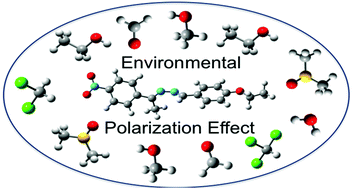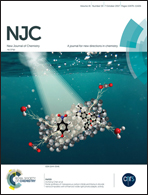The solid state structure and environmental polarization effect of a novel asymmetric azine†
Abstract
A broad analysis of a novel azine is reported using single crystal X-ray diffraction and characterization methods (IR, NMR and MS). Additional studies were conducted using density functional theory with the CAM-B3LYP functional and the 6-311+G(d) basis set, with the intention of calculating molecular structure optimization, vibrational frequencies, and the intensity of the vibrational bands. These results were seen to be in close agreement with those reported in the literature. Besides that, we determined the linear polarization (α) and the second hyperpolarizability (γ) of this new azine to understand its linear and nonlinear optical behaviour in both static and dynamic cases. A new supermolecule approach is employed, combined with an interactive electrostatic system in which the atoms of the neighbouring molecules are considered as point charges. The ab initio computational results of (hyper) polarizabilities derived from an iterative process confirm this crystal as a good candidate for photonic devices, such as optical switches, modulators, pyrazoline derivatives, and optical power applications. Besides that, we also calculated the effect of the solvent on the nonlinear optical properties of the title compound.



 Please wait while we load your content...
Please wait while we load your content...